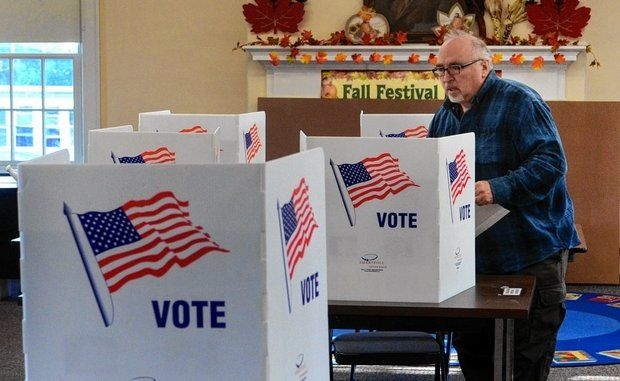By STEVEN SHEPARD
Nearly three-quarters of the Democratic vote will be cast in the New York City media market. But on the GOP side, most of the votes will be cast far from the city.
Two New Yorks are voting on Tuesday.
In the Democratic presidential primary, about half the vote will come from New York City’s five boroughs — a percentage that increases to nearly three-quarters of the vote when the entire New York media market is included.
By contrast, the city accounted for only 13 percent of the votes in the 2012 Republican primary. And of the 34 counties across the state where registered Republicans outnumber Democrats (out of 62), only one — Putnam County — is located near New York City.
But with Donald Trump in a pitched effort to lock down a majority of delegates before July’s Republican convention — and the bulk of New York’s GOP delegates distributed by congressional district — suddenly the overwhelmingly Democratic New York City districts take on outsized importance since they award the same number of delegates as the redder upstate districts.
Polls close statewide at 9 p.m. eastern time. Here are the places to watch as the results trickle in.
Democrats:
Upper Manhattan: The 2008 Democratic primary was historic — but it wasn’t especially competitive in New York: Hillary Clinton won more than 57 percent of the vote, easily holding serve in her home state over Barack Obama.
No district produced more votes in the Democratic primary that year than the seat held for the past quarter-century by Rep. Charles Rangel. More than 115,000 votes were cast in Rangel’s majority-minority district in 2008 — which includes historically African-American Harlem and heavily Dominican Washington Heights — and Clinton won 53 percent of the vote there.
The 2016 campaign has realigned the Democratic electorate — now, Clinton is winning about eight-in-10 black voters. That makes Rangel’s district — which has changed slightly due to redistricting and now takes in some of the Bronx — critical to her efforts. While polls show Clinton is poised to equal her 2008 vote percentage statewide, she’ll likely run well ahead of her past performance in Rangel’s district.
That could help Clinton offset losses elsewhere in Manhattan among progressives — losses possibly telegraphed by the performance of Zephyr Teachout, the liberal college professor who won many precincts in Lower Manhattan and in areas around Columbia University in the 2014 gubernatorial primary, even though incumbent Gov. Andrew Cuomo carried the borough by about 10,000 votes.
Long Island: Nassau and Suffolk counties will account for about one-in-10 votes in the Democratic primary on Tuesday, and this should be Clinton Country. The then-senator carried both suburban counties easily in 2008, and, two years ago, Cuomo beat Teachout on the Island by nearly 2-to-1.
But there’s a distinction between the two counties: The bedroom communities in Nassau — which include prototypical middle-class suburbs like Levittown, minority communities like Hempstead and wealthy hamlets on the North Shore— are strongly for Clinton.
Sanders should fare better in Suffolk, which becomes more rural farther east from the city — Teachout won 40 percent of the vote in Suffolk, compared to 31 percent in Nassau.
Hudson Valley: Clinton and her husband have a home in Chappaqua, in Westchester County. But the Hudson Valley — from Westchester heading upriver into Rockland, Putnam, Dutchess and Orange counties — is competitive territory.
Clinton won 52 percent of the vote in Westchester in 2008, 51 percent in Dutchess, 58 percent in Rockland, 56 percent in Putnam and 57 percent in Orange.
In 2014, Teachout won Dutchess and Putnam counties, and lost narrowly in Orange. Cuomo carried Westchester and Rockland by healthier margins.
Ithaca: If Sanders is going to pull off a remarkable upset on Tuesday, he’ll need to run up large margins in Ithaca — the closest New York has to a true college town. Home to both Cornell University and Ithaca College, Tompkins County has bucked the statewide trend in a number of recent Democratic primaries.
Obama won 58 percent of the vote there in 2008, and Teachout won an overwhelming 70 percent in the 2014 gubernatorial primary.
But Tompkins County is a very small slice of the Democratic electorate: It represented around 1 percent of the vote in both 2008 (0.7 percent) and 2014 (1.3 percent).
North Country: The North Country is the least populous, and most Republican, part of the state — but it’s also home to voters who have been familiar with Sanders for years. That’s because Burlington — the Vermont city Sanders governed as mayor — lies just across Lake Champlain from New York.
Clinton carried those North Country counties in 2008, but many of them were closely contested between Cuomo and Teachout in 2014. Given voters’ familiarity with Sanders, the Vermonter will need to overperform here to counter Clinton’s advantages downstate.
Buffalo: Western New York may at times feel like a different state, but the Buffalo region is critical for Sanders. Other than Nassau, Erie County produced more votes in the 2008 Democratic primary than any other noncity, with Clinton winning 60 percent of the vote.
But there’s a danger sign for Sanders from the 2014 gubernatorial primary: Despite winning 40 percent of the statewide vote, Teachout captured just 18 percent in Erie County as she challenged Cuomo from the left.
Republicans:
Northern Nassau County: Long Island is mostly Trump Country, but John Kasich has spent a significant amount of time on the Island — with the 3rd Congressional District his most likely target.
The 3rd District is the ninth-wealthiest in the country — snaking from Huntington, in Suffolk County, west through the tony North Shore of Nassau County, into northern Queens.
If Kasich is to hold Trump under 50 percent and steal a delegate from Long Island, it will be from this district.
Staten Island: New York City contains parts of 13 congressional districts, but a quarter of the city’s registered Republicans come from a single district: the 11th, which comprises all of Staten Island and parts of southern Brooklyn.
Trump — who held an event on Staten Island on Sunday — is expected to win a majority of the vote in the 11th and take all three delegates up for grabs. But it’s also a place where he can pad his statewide margin in his quest to win a majority of the vote, which would trigger a winner-take-all provision for statewide delegates.
South Bronx: The contrast between the Staten Island-based 11th District, where almost 6,000 Republicans voted in the 2012 GOP presidential primary, and the Bronx-based 15th District is stark — the 15th is the most Democratic district in the nation.
Only 285 Republicans cast ballots in the 2012 GOP presidential primary in Rep. José Serrano’s district — but both districts will award the same number of delegates on Tuesday.
That’s why Kasich spent a day eating his way through the historically Italian Belmont section of The Bronx, including a trip to a deli inside the Arthur Avenue food market. The Ohio governor could steal a delegate or two from the most Democratic districts in the city if he holds Trump under 50 percent.
New Square: The Hudson Valley is home to two sizable Hasidic Jewish communities that sometimes vote as a bloc: New Square, in the 17th Congressional District, and Kiryas Joel, in the 18th District.
These places are where the efforts of Kasich and Ted Cruz to court Jewish voters could pay off. Cruz visited a matzoh bakery in Brooklyn and spoke to a Jewish group in the heavily Russian community of Brighton Beach.
Capital Region: Three different congressional districts touch the Capital Region — the 19th, 20th and 21st — and with his background in state government, Kasich is making a play for delegates in each of them. He held events in Troy (19th), Saratoga Springs (21st) and far-flung Watertown (at the northern end of the expansive 21st), and diverted some advertising funds to Albany in the closing days of the campaign.
Moving west, Kasich also visited Utica, in the 22nd District. And, also in the 22nd, Cruz held a town hall meeting in Binghamton, near the Pennsylvania border.
Buffalo: There are five congressional districts in Western New York — and five chances for Kasich and Cruz to hold Trump short of a majority of the vote.
Trusted Leadership PAC, a super PAC backing Cruz, spent more than $300,000 on cable-TV advertising in the final week of the campaign — more than half of it in Buffalo, Rochester and Syracuse.
Trump went to Buffalo to close out his New York campaign on Monday night. Carl Paladino, the Republican upstart who won a surprise victory in the 2010 gubernatorial primary and has since won election to the Buffalo School Board, is Trump’s honorary state campaign chairman.
The 27th District — which takes in many of the Buffalo and Rochester suburbs — has more registered Republicans than any other district in the state.



















